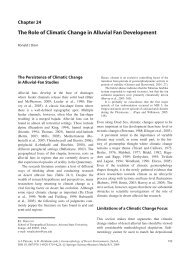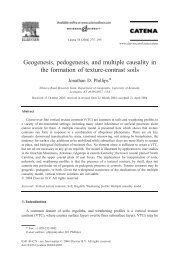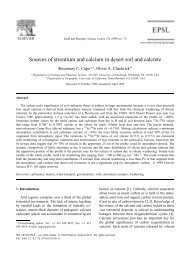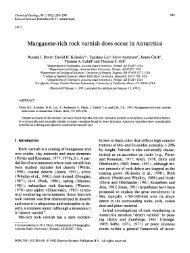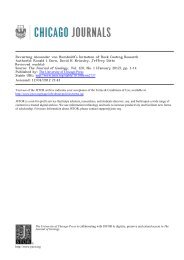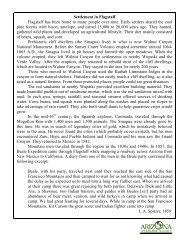Dorn, R. 2004. Experimental approaches to dating petroglyphs
Dorn, R. 2004. Experimental approaches to dating petroglyphs
Dorn, R. 2004. Experimental approaches to dating petroglyphs
Create successful ePaper yourself
Turn your PDF publications into a flip-book with our unique Google optimized e-Paper software.
<strong>Experimental</strong> Approaches <strong>to</strong> Dating Petroglyphs and Geoglyphs with Rock Varnish in the California Deserts:<br />
Current Status and Future Directions<br />
Figure 10. Organic carbon ratios (OCRs) and relative OCR ages of varnish samples collected from varnish layers, where measurements for<br />
different layers are connected by lines. For each line, OCRs generally increase with depth in progressively lower layers in varnish<br />
scrapings. Natural pavement and cross geoglyph samples were collected from the Ripley Geoglyph site, and the spiral petroglyph was<br />
collected from the Coso Range (cf. Figure 5).<br />
The hope of this research is that it might be possible at some<br />
point <strong>to</strong> model OCR ages much in the way that mean<br />
residence time (MRT) radiocarbon ages on soil A-horizons<br />
are modeled <strong>to</strong> record the onset of soil formation. The key<br />
will be obtaining these OCR depth profiles at locations<br />
where ages are known independently, through blind testing,<br />
prior <strong>to</strong> the onset of modeling research.<br />
CONCLUDING THOUGHTS ON<br />
RESOLVING UNCERTAINTIES<br />
The future of varnish research in the California Desert and<br />
elsewhere continues <strong>to</strong> be hampered by a "hit and run"<br />
research tradition with two characteristics. First, very few<br />
researchers focus on rock varnish long enough <strong>to</strong> understand<br />
its varieties and the necessity <strong>to</strong> use multiple analytical<br />
<strong>approaches</strong>; rather, these researchers take an analytical<br />
technique or two they happen <strong>to</strong> be familiar with and apply<br />
them <strong>to</strong> rock varnish. Second and far more importantly,<br />
many researchers fail <strong>to</strong> comprehend that their initial visual<br />
impressions are untrained and limited; hence, they operate as<br />
though they believe that all rock varnishes are the same. This<br />
is not true (<strong>Dorn</strong> 1998), much in the way that not all lithics<br />
or pottery fragments are the same. The literature on rock<br />
varnish and varnish <strong>dating</strong> is peppered with papers written<br />
by researchers who grab a few samples, do not characterize<br />
or communicate the type of varnish analyzed or collected —<br />
and generalize their findings <strong>to</strong> the entire field. Certainly,<br />
this approach <strong>to</strong>wards research is not unique <strong>to</strong> rock varnish<br />
(Fuller 2000), but it does plague the field. On the flip side,<br />
science must be replicable, and "hit and run" drivers - no<br />
matter how poorly intentioned and poorly trained <strong>to</strong> go<br />
behind the wheel - do help others isolate potential<br />
complications and communicate more clearly methods and<br />
interpretations.<br />
A far more serious issue is the ethical imperative ignored by<br />
academic archaeologists. As a geographer looking in<strong>to</strong> the<br />
220<br />
foreign field of archaeology, I am utterly dumbfounded by<br />
academic archaeologists living on the doorstep of<br />
California’s Deserts — yet focusing their attention on<br />
research <strong>to</strong>pics that are in no immediate or even long-term<br />
peril of destruction. Unlike resource managers and contract<br />
archaeologists attempting <strong>to</strong> understand, protect, and salvage<br />
what they can in the wake of tremendous population<br />
pressures, academic archaeologists have the freedom <strong>to</strong> pick<br />
the pleasure of their research focus. Please, for the sake of<br />
future generations, I beg academic archaeologists <strong>to</strong><br />
encourage their students <strong>to</strong> work <strong>to</strong>wards understanding rock<br />
art before it disappears forever. Future academic<br />
archaeologists will surely condemn inactivity on rock art<br />
research as one of the greatest tragedies of the discipline —<br />
literally letting a golden treasure slip underneath collective<br />
noses. Future academic archaeologists surrounding the<br />
California desert will most assuredly highlight inactivity as<br />
evidence that their predecessors were little more than range<br />
animals led by academic shepherds concerned only with<br />
winning little internal disciplinary squabbles — what Fuller<br />
(2000) calls "normal science". I hope that <strong>to</strong>day’s academic<br />
archaeologists develop the internal ethical compass <strong>to</strong> work<br />
<strong>to</strong>wards understanding our collective cultural heritage before<br />
it is forever lost. These are the thoughts of an outsider<br />
looking in.<br />
As a geographer with a career focused on the geography of<br />
rock decay, I feel an ethical imperative <strong>to</strong> discern as much<br />
information as possible from the global cultural heritage of<br />
rock art before it disappears from the onslaught of<br />
anthropogenic destruction. Thus, I will continue <strong>to</strong> urge<br />
students and colleague researchers <strong>to</strong> develop and test<br />
experimental <strong>approaches</strong> <strong>to</strong> work <strong>to</strong>wards understanding the<br />
human condition through the nexus of art, religion, and<br />
science exhibited in rock art (Whitley et al. 1999a,b).




